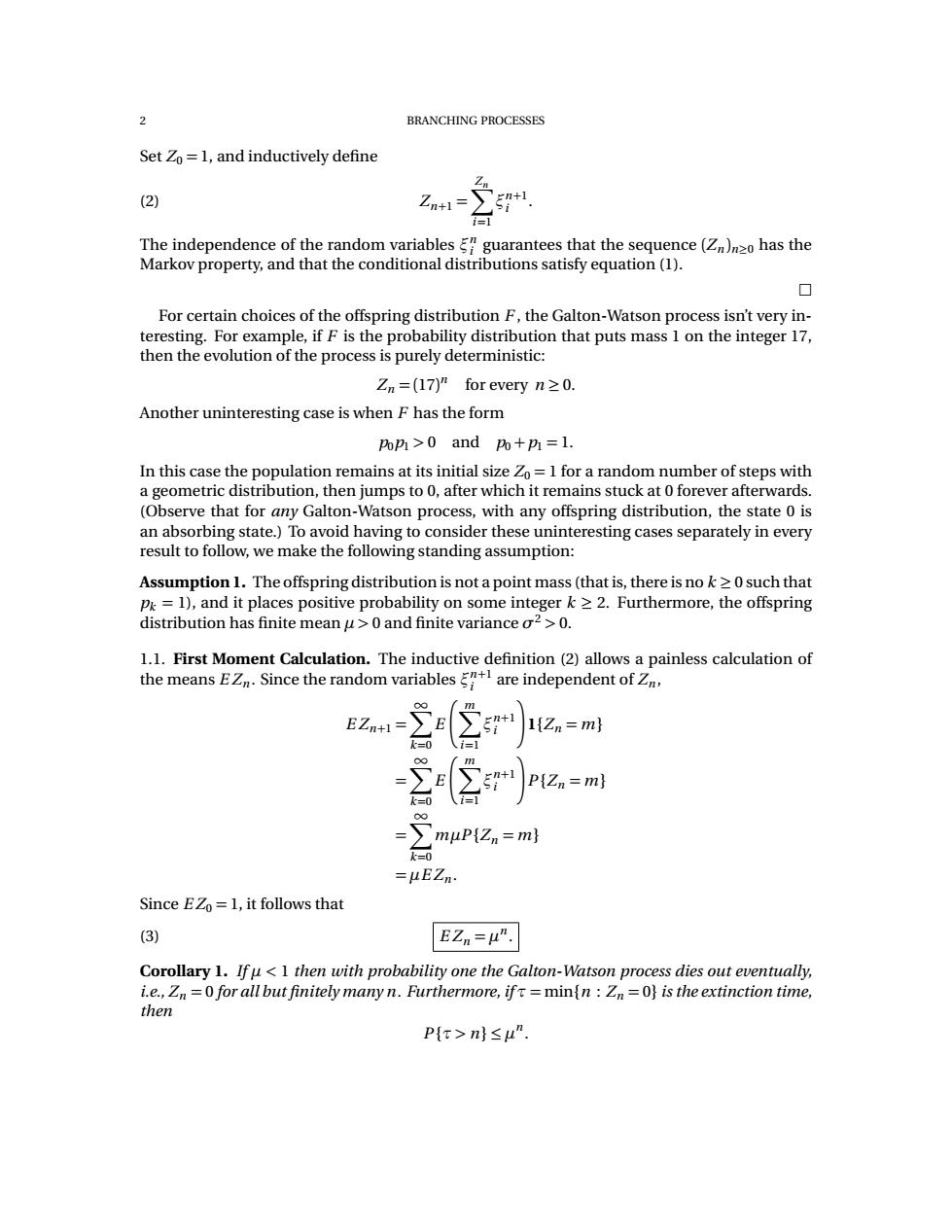正在加载图片...

2 BRANCHING PROCESSES Set Zo=1,and inductively define (2) Zn+1= rn+l The independence of the random variables"guarantees that the sequence(Zn)nzo has the Markov property,and that the conditional distributions satisfy equation(1). 0 For certain choices of the offspring distribution F,the Galton-Watson process isn't very in- teresting.For example,if F is the probability distribution that puts mass 1 on the integer 17, then the evolution of the process is purely deterministic: Zn =(17)"for every n20. Another uninteresting case is when F has the form popi>0 and po+p=1. In this case the population remains at its initial size Zo=1 for a random number of steps with a geometric distribution,then jumps to 0,after which it remains stuck at 0 forever afterwards. (Observe that for any Galton-Watson process,with any offspring distribution,the state 0 is an absorbing state.)To avoid having to consider these uninteresting cases separately in every result to follow,we make the following standing assumption: Assumption 1.The offspring distribution is not a point mass(that is,there is no k>0 such that p=1),and it places positive probability on some integer k >2.Furthermore,the offspring distribution has finite mean u>0 and finite variance o2>0. 1.1.First Moment Calculation.The inductive definition(2)allows a painless calculation of the means EZ Since the random variables are independent ofZ 1(Zn =m} i=1 P(Zn =m} =∑muPiZn=-ml 司 =uEZn. Since EZo=1,it follows that (3) EZn=u". Corollary 1.Ifu<1 then with probability one the Galton-Watson process dies out eventually, i.e.,Zn=0 for all but finitely many n.Furthermore,if=min{n:Zn=0}is the extinction time, then P{r>n}≤un2 BRANCHING PROCESSES Set Z0 = 1, and inductively define (2) Zn+1 = X Zn i=1 ξ n+1 i . The independence of the random variables ξ n i guarantees that the sequence (Zn )n≥0 has the Markov property, and that the conditional distributions satisfy equation (1). For certain choices of the offspring distribution F , the Galton-Watson process isn’t very interesting. For example, if F is the probability distribution that puts mass 1 on the integer 17, then the evolution of the process is purely deterministic: Zn = (17) n for every n ≥ 0. Another uninteresting case is when F has the form p0p1 > 0 and p0 + p1 = 1. In this case the population remains at its initial size Z0 = 1 for a random number of steps with a geometric distribution, then jumps to 0, after which it remains stuck at 0 forever afterwards. (Observe that for any Galton-Watson process, with any offspring distribution, the state 0 is an absorbing state.) To avoid having to consider these uninteresting cases separately in every result to follow, we make the following standing assumption: Assumption 1. The offspring distribution is not a point mass (that is, there is no k ≥ 0 such that pk = 1), and it places positive probability on some integer k ≥ 2. Furthermore, the offspring distribution has finite mean µ > 0 and finite variance σ2 > 0. 1.1. First Moment Calculation. The inductive definition (2) allows a painless calculation of the means E Zn . Since the random variables ξ n+1 i are independent of Zn , E Zn+1 = X∞ k=0 E Xm i=1 ξ n+1 i 1{Zn = m} = X∞ k=0 E Xm i=1 ξ n+1 i P {Zn = m} = X∞ k=0 mµP {Zn = m} = µE Zn . Since E Z0 = 1, it follows that (3) E Zn = µ n . Corollary 1. If µ < 1 then with probability one the Galton-Watson process dies out eventually, i.e., Zn = 0 for all but finitely many n. Furthermore, if τ = min{n : Zn = 0} is the extinction time, then P {τ > n} ≤ µ n .�